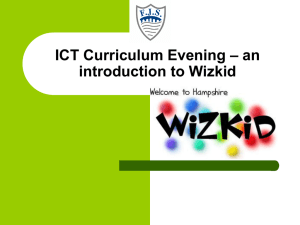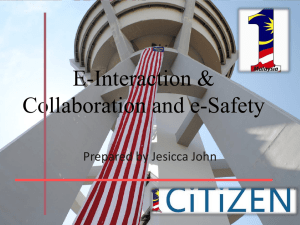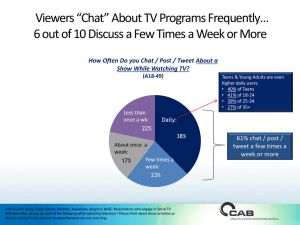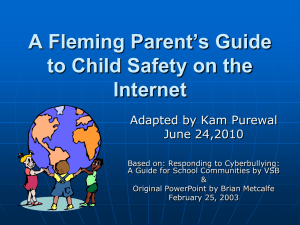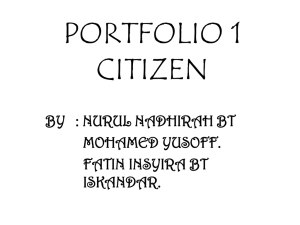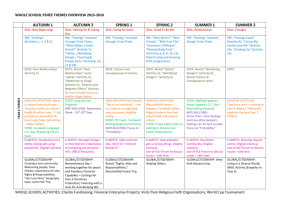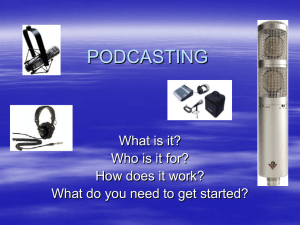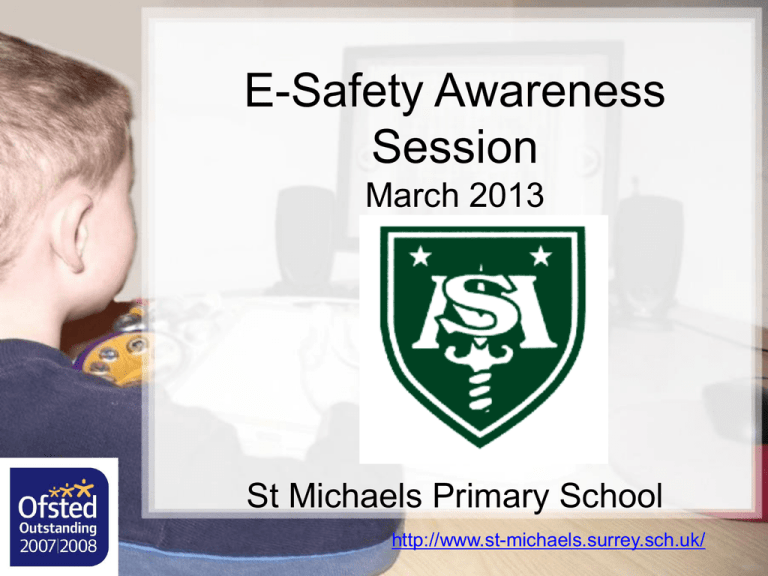
E-Safety Awareness
Session
March 2013
St Michaels Primary School
http://www.st-michaels.surrey.sch.uk/
1/15
Aims of this session:
• To look at how your children are using
the Internet
• To raise awareness of E Safety issues
• To consider ways of supporting
parents/ carers
• To offer guidance on keeping your
child safe
2/15
Consider how we use these technologies
Parents / Carers
e-mail
Shopping
Booking holidays
Research
Young people
Music
Games
Chat
Instant Messaging IM
Blogs
Social Networking
3/15
Some of the technologies your child is
experiences to daily …
Mobile phones
Which does your child use?
Instant
messaging
Social
networking
BLOGS
Music
Download
sites
E-mail
Gaming sites
Wikies
Podcasting
Chat Rooms
P2P
file-sharing
Video
broadcasting
Text
4/15
BLOGS
• Blog is short for web log or online diary
• Easy to create and use
• Easy to add comments and share ideas or
opinions
1% of parents thought their child blogged
33% of children used blogs
67% of parents didn’t know what a blog was
Stats by UK Children Go Online
5/15
Are our children and young people
aware of the risks?
6/15
Mobile
phones
Anytime Anywhere
Text messages
Camera phones
Internet access
e-mail
MP3 player
Downloads
Mobile TV
Chat and IM
7/15
Podcasting
• Podcasting is publishing radio style sound
recordings on a website. It’s like a radio show stor
as an MP3 file.
• By podcasting, you can broadcast to the world
without the need for specialist equipment or a
licence.
• It is a great way to share work
Podcast’ (from
‘ipod’ and
‘broadcast’)8/15
Chat Rooms
Instant
messaging
• Chat Rooms are websites or part of websites
that provide an area for communities with
common interests to chat in real time. Many
Many
• Instant Messaging IM is a way of
communicating with another individual in real
time across the internet using text-based not
voice communication. One One
79% of children use IM
29% of parents don’t know what IM is
Stats from Get I.T. safe NCH 11 – 16 year olds
9/15
Wikies
10/15
Social
networking
• Based
on the idea of networking with friends and
friends of friends
•49% of the 3,000 children surveyed by Ofcom
have a social networking profile
11/15
Video
broadcasting
• Video sharing websites are where users
can upload, view and share video clips
• Videos can be rated and the number of times
viewed recorded
• Video recorded with mobile phones can easily
upload
• YouTube is one of the ten most popular websites
12/15
Gaming sites
• Role-play, adventure and life
simulations are becoming very
popular
• Added extra elements of selfexpression and personalisation
• Play on-line with other gamers from
around the world
• Play in real-time
13/15
P2P
file-sharing
• File-sharing or peer-to-peer (P2P) are terms
used to describe sharing files (resources)
directly between computers.
• To get started you will need to download P2P
software from a website
• This software creates a ‘shared media’ folder
on your computer from which other P2P users
can access your files
• You can then exchange music, videos, games
etc with other P2P users
14/15
The need for e-safety
Half (49%) of young people questioned say they have
given out personal information, such as their full
names, ages, email addresses, phone numbers, hobbies
or names of their schools, to someone they met on the
internet.
By contrast, only 5% of parents think their child has
given out such information. (Source: UK Children Go Online.)
Prior to the launch of the Child Exploitation and Online
Protection Centre (CEOP), there was no centralised
collection of details of internet-related abuse in the UK,
and not all victims reported incidents.
15/15
The Byron Review
Focussed on the school ensuring children are e-safe by
“reducing availability, restricting access and increasing
resilience”
Building “children’s resilience to the material to which
they may be exposed so that they have the confidence
and skills to navigate … more safely”
Ensure that new teachers entering the profession are
equipped with e-safety knowledge and skills.
Making explicit teaching and learning about e-safety.
Identifying home-school links as a key issue.
16/15
The 3 Cs of e-safety
One third of young people who go online at least once a week report having received
unwanted sexual (31%) or nasty comments (33%) via email, chat, instant message or
text message. Only 7% of parents think their child has received such comments.
UK Children Go Online, 2005, 9-19 year olds
17/15
Why is education so
important in this area?
55% access the internet everyday
47% for an hour or more
21% liked IM/Chat the most
15% used gaming sites
33% had access in their bedrooms
25% have met someone offline
83% have taken a friend
(CEOP, 2007)
18/15
Challenges Young People Maturity
• Like to post images and reveal personal
information
• Want lots of ‘friends’
• Talk about their peers
• Use inappropriate nicknames
• Express insecurities and fantasies
• Trick others to make silly, embarrassing,
dangerous acts with video or webcam
• Push boundaries
19/15
• CEOP works across the UK and maximises
international links to tackle child sex abuse wherever
and whenever it happens.
• provides internet safety advice for parents and carers
• provides information on internet safety and safe
surfing for young people aged 11 to 16 years
• report facility
enabling anyone to report any
inappropriate or potentially illegal activity with or
towards a child online
20/15
Organisations
E Safety information sites for you to be aware of:
21/15
Materials and Resources
Materials and resources on e-safety sites which children can use:
Staying safe with
Dongle (KS1)
The Smart Crew
(KS2)
Us Online
(KS2/3)
Hector’s World
(KS1)
Cyber Café
(KS2)
Lee and Kim
(KS1/2)
22/15
E Safety & learning resources to take
home:
www.thinkuknow.com
http://www.childnet-int.org/
http://www.bbc.co.uk/webwise/
http://www.iwf.org.uk/
http://www.getnetwise.org/
http://www.bbc.co.uk/learningzone/clips/
iKeepSafe.org
http://www.bbc.co.uk/cbbc/topics/stay-safe
www.kidsclick.org
http://kids.yahoo.com/
www.askforkids.com
http://www.cybersmart.gov.au/cyberquoll/html/parents.html
23/15
Over to you – consider:
• How aware are you of E Safety issues?
• Has your child experienced threats to their E
Safety?
• Do you and your child talk about using the
internet safely?
24/15
Home and Family Guidelines
☺ Practical principles
Talk with your children and agree family
guidelines and rules.
Discuss regularly online safety.
☺ Infrastructure
Virus and firewall software up to-date,
Browser ‘safe search’ enabled.
☺ Education
Learn together about new technologies
and enjoy! Reflect together about new
technologies, the benefits, dangers and
their potential.
☺ Systems
Keep webcams in family rooms
Monitor time spent on the internet
View the ‘History’ or purchase filtering
software.
25/15
Remember …
For most children, using the wide
variety of modern technologies is a
positive and fun experience.
There are wonderful, exciting ways of
using the internet positively including for homework!
26/15
27/15

